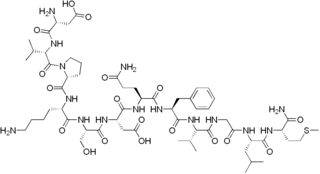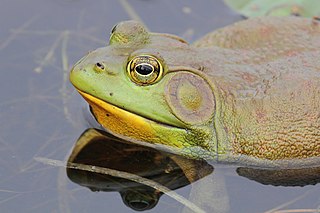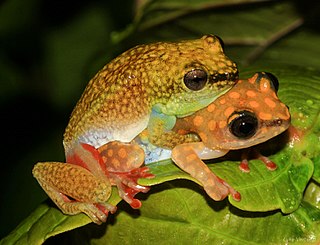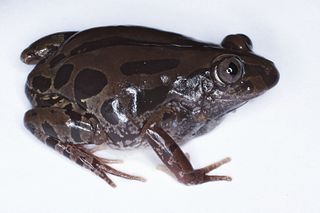
A frog is any member of a diverse and largely carnivorous group of short-bodied, tailless amphibians composing the order Anura. The oldest fossil "proto-frog" Triadobatrachus is known from the Early Triassic of Madagascar, but molecular clock dating suggests their split from other amphibians may extend further back to the Permian, 265 million years ago. Frogs are widely distributed, ranging from the tropics to subarctic regions, but the greatest concentration of species diversity is in tropical rainforest. Frogs account for around 88% of extant amphibian species. They are also one of the five most diverse vertebrate orders. Warty frog species tend to be called toads, but the distinction between frogs and toads is informal, not from taxonomy or evolutionary history.

The Hyperoliidae, or sedge frogs and bush frogs, are a large family of small to medium-sized, brightly colored frogs which contains more than 250 species in 19 genera. Seventeen genera are native to sub-Saharan Africa. In addition, the monotypic genus Tachycnemis occurs on the Seychelles Islands, and the genus Heterixalus is endemic to Madagascar.

Rana is a genus of frogs commonly known as the Holarctic true frogs, pond frogs or brown frogs. Members of this genus are found through much of Eurasia and western North America. Many other genera were formerly included here. These true frogs are usually largish species characterized by their slim waists and wrinkled skin; many have thin ridges running along their backs, but they generally lack "warts" as in typical toads. They are excellent jumpers due to their long, slender legs. The typical webbing found on their hind feet allows for easy movement through water. Coloration is mostly greens and browns above, with darker and yellowish spots.

Kassinin is a peptide derived from the Kassina frog. It belongs to tachykinin family of neuropeptides. It is secreted as a defense response, and is involved in neuropeptide signalling.

Lithobates is a genus of true frogs, of the family Ranidae. The name is derived from litho- (stone) and the Greek bates, meaning one that treads on rock, or rock climber.

Hyperolius is a large genus of frogs in the family Hyperoliidae from Sub-Saharan Africa.

Hyperolius guttulatus is a species of frog in the family Hyperoliidae. It occurs in West and Middle Africa between Sierra Leone in the west and Gabon in the east/south. Common name dotted reed frog has been coined for this species.
Hyperolius sylvaticus is a species of frog in the family Hyperoliidae. It is found in southern Ivory Coast, Ghana, Togo, Nigeria, and western Cameroon, with a gap in Benin. It is also likely to occur in Liberia. Common name Bobiri reed frog has been coined for this species.
Hyperolius torrentis is a species of frog in the family Hyperoliidae. It is known from the Akwapim-Togo Ranges along the border between Ghana and Togo as well as from northeastern Benin. Common name Ukami reed frog has been coined for this species.
Kassina cassinoides, also known as large running frog or silver running frog, is a species of frog in the family Hyperoliidae. It is found in Cameroon and—disjunctly—in West Africa, specifically in in Senegal, the Gambia, Mali, Burkina Faso, Ivory Coast, Ghana, Togo, and Benin. It might occur more broadly, and presumably occurs in Guinea, Guinea-Bissau, Niger, Nigeria, and Mauritania.
Kassina cochranae, sometimes known as the Cochran's running frog, is a species of frog in the family Hyperoliidae. It is found in southern Guinea, Liberia, Sierra Leone, western Ivory Coast, and at least tentatively, southern Ghana. Kassina arboricola was for a period treated as a subspecies Kassina cochranae arboricola, but it is now considered a valid species.
Kassina fusca is a species of frog in the family Hyperoliidae. Its common name is brown running frog or pale running frog. It is found in the West African savanna zone in Senegal, Gambia, Guinea, Mali, Burkina Faso, Ivory Coast, Ghana, Togo, Benin, Niger, and Nigeria. It probably occurs in Guinea-Bissau, although there are no records from there.

Phlyctimantis maculatus is a species of frog in the family Hyperoliidae. They are silvery greyish-brown with dark brown to black spots, and derive their name from bright red coloring on the ventral side of their hind legs. Adult body length is typically 6 to 7.5 centimeters. These frogs have vertical pupils. Common names include red-legged running frog, brown-spotted tree frog, red-legged Kassina, red-legged pan frog, spotted running frog, tiger leg running frog, and vlei frog.
Kassina schioetzi is a species of frogs in the family Hyperoliidae. It is found in Ivory Coast and extreme southeastern Guinea. Its range probably extends into northwestern Ghana.

Kassina senegalensis, also known as the Senegal running frog, along with many other common names, is a species of frog native to much of Africa. It is a small and solidly-built species with large eyes. Most of the body is greyish-black, but there are brown bands and spots on certain parts. They can be found in many types of habitats, such as shrublands, grasslands, and wetlands, at elevations as high as 2,000 metres (1.2 mi). Their breeding occurs in water, where eggs are laid in various locations and fertilised one by one. They eat a variety of arthropods and secrete peptides from their skin to avoid becoming prey themselves. Their population is assumed to be very large and not in any immediate danger.

The savannah forest tree frog or ground tree frog is a species of frog in the family Arthroleptidae. It occurs in West and Middle Africa. The relationship of this species with Leptopelis bocagei is not fully settled.

Leptopelis macrotis, sometimes called the big-eyed forest tree frog, is a species of frog in the family Arthroleptidae. It is found in the rainforests of Sierra Leone, southern Guinea, Liberia, Ivory Coast, and southern Ghana. Notice that similar common name "big-eyed tree frog" is sometimes used for Leptopelis vermiculatus from Tanzania and for Litoria exophthalmia from New Guinea.

The Tai forest tree frog is a species of frog in the family Arthroleptidae. It is found in Liberia, southern Ivory Coast, and Ghana. Records from Nigeria are controversial and may refer to other species, possibly Leptopelis boulengeri.
Kassina jozani is a species of frogs in the family Hyperoliidae. It is endemic to Tanzania and only known from the Jozani Forest on the Unguja Island (Zanzibar).












